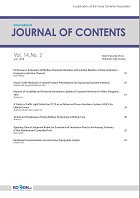- Log In/Sign Up
- P-ISSN1738-6764
- E-ISSN2093-7504
- KCI
 ISSN : 1738-6764
ISSN : 1738-6764
Vol.4 No.4
Abstract
In this paper, we propose improved loop splitting method for maximizing parallelism of single loops with non-constant dependence distances. By using the iteration and distance for the source of the first dependence, and by our defined theorems, we present generalized and optimal algorithms for single loops with non-uniform dependences (MPSL). By the extension of the MPSL method, we also apply to exploit parallelism from nested loops with simple subscripts, based on cycle shrinking and loop interchanging method. The algorithms generalize how to transform general single loops with non-uniform dependences as well as nested loops with simple subscripts into parallel loops.
Abstract
This paper embodies the agent based cinder monitoring system which supports PDA(Personal Digital Assistant). Monitoring system automatically manages data by using data managing agents such as a state managing agent, a location managing agent, a badness managing agent, a circumstances managing agent, etc, and uses a massive data processing agent to manage massive data. The development of agent based data monitoring system for the stable cinder reuse will be an epoch-making method to develop the process mechanized or manual-labored that widely spreads into the real-time automated process.
Abstract
The web 2.0 is leading a rapid change of internet services. The UCC(User Created Contents) service is one of the representative internet services with web 2.0 paradigm. In this paper, we design and implement the UCC services prototype system for image and video. The proposed system does not need to install ActiveX and client programs on devices of users to edit their contents. All processes for editing UCC are conducted on the server. Our proposed system consists of the two components such as the multimedia editing subsystem and the metadata management system. They provide the API to UCC service developers or vendors. The multimedia editing subsystem supports editing for image and video, and the streaming services of video. The metadata management subsystem supports the metadata management and retrieval of image and video.
Abstract
With the development of information communication and network technologies, ubiquitous era that supports various services regardless of places and time has been advancing. The development of such technologies has a great influence on educational environments. As a result, e-learning concepts that learners use learning contents in anywhere and anytime have been proposed. The various learning contents authoring systems that consider the e-learning environments have also been developed. However, since most of the existing authoring systems support only PC environments, they are not suitable for various ubiquitous mobile devices. In this paper, we design and implement a contents authoring system based on learning activities for u-learning environments. Our authoring system significantly improves the efficiency for authoring contents and supports various ubiquitous devices as well as PCs.
Abstract
In 1920s, Soviet silent films enjoyed unprecedentedly great prosperity throughout world film history. Particularly, Dziga Vertov could develop ‘montage’ in collaboration with Sergei Eisenstein and thereby could work as the engines behind development and leap of Soviet films toward ‘new concepts’ of ‘new films’ worldwide. However, Vertov’s original reputations - the best film theorist and avant-gardist as well as great cineaste in his contemporary age - have been misunderstood or underestimated, so that he has been still misestimated or distorted as radical formalist and documentary propagandist. In regard to these points, this study aims to take Gilles Deleuze’s modal esthetic approaches to further considering and historically re-highlighting D. Vertov’s film theories that are based on the principle of ‘film-reality’ and the concept of ‘Life As It Is’ according to ‘kino-eye’ method and ‘interval’ theory as a part of futurism and constructivism breaking down any attribute of traditional narrative films.
